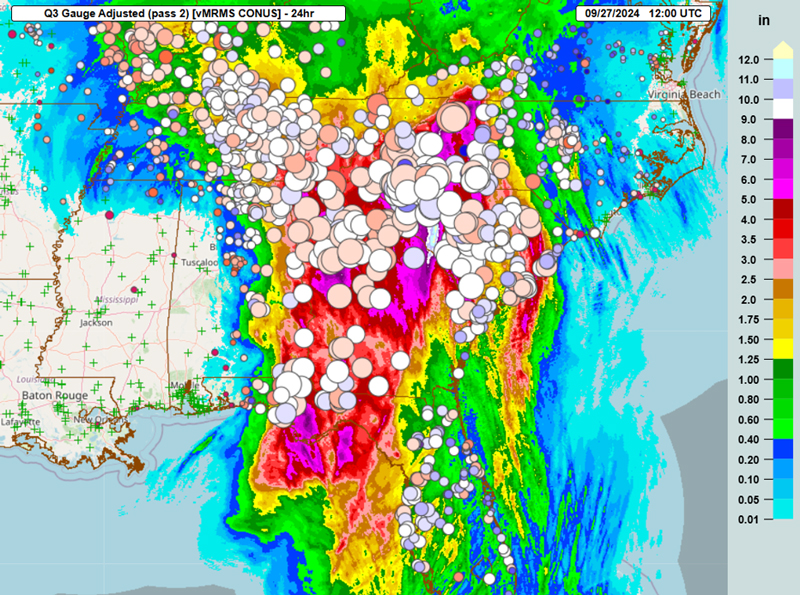NOAA’s National Severe Storms Laboratory (NSSL) and the University of Oklahoma’s Cooperative Institute for Severe and High-Impact Weather Research and Operations (CIWRO) are advancing real-time environmental data processing with the Multi-Radar Multi-Sensor (MRMS) system, and they’re collaborating with Synoptic Data to ensure that they are continuously improving on the precipitation services the MRMS system provides.

Solving a Fragmented Data Problem
Before working with Synoptic, the MRMS team had to pull rain gauge data from multiple sources, each with its own access protocols and various quirks. This fragmented setup complicated the hourly data ingest and decoding process, which was a time-consuming and maintenance-heavy task.
By integrating Synoptic’s Weather API, the team gained access to a unified, authoritative feed of precipitation observations aggregated through the National Mesonet Program, as well as from other Synoptic-aggregated data providers. The result? A more complete picture with significantly less effort.
“The ability to access more gauges with less latency has real operational impact. We can integrate observations more quickly and work toward streamlining MRMS gauge-based product generation from two hourly passes to just one,” shared CIWRO’s Steven Martinaitis, who helps lead the MRMS hydrometeorology and remote sensing team.
Responsive, Reliable, and Ready for Operations
The core goal of MRMS is operational readiness. The MRMS team has been testing Synoptic’s Weather API in near-real-time conditions, examining performance under high data volumes and across a wide spatial domain.
The verdict: more gauge data, faster delivery, and reliable performance.
As a result of this collaboration, Synoptic is in the process of making several updates to its services to better meet MRMS requirements. This responsiveness has led to new efficiencies in how gauge data is ingested and when derived products are generated — improvements that are already shaping future development priorities for both teams. Martinaitis added, “It’s more than just access, it’s a collaboration that’s advancing both science and operations.”
What’s Next: From Research to Operations
The next step for NSSL and CIWRO is to fully integrate Synoptic’s Weather API into a test version of the real-time MRMS system. This controlled environment closely mirrors operational conditions at the National Weather Service, allowing for robust testing and validation. The end goal of this project is to determine if the API service can provide a suitable alternative to MADIS. MADIS is frozen to the inclusion of new data sources and to significant enhancements in its processing capabilities. Providing an alternative to MADIS with a growing footprint of observations in an up-to-date processing environment is necessary for the advancement of not only MRMS, but also other applications and systems that rely on MADIS for observational input data. To this end, should performance of this effort with CIWRO and NSSL continue to meet requirements, the Synoptic Weather API would become a key source for the core operational MRMS infrastructure.
Beyond immediate improvements to precipitation estimation, the success of this initiative opens new avenues for integrating other types of environmental observations into MRMS workflows. The ability to ingest diverse, quality-controlled datasets through a single, scalable interface, such as provided by Synoptic, has the potential to enhance future scientific research, operational products, and public safety outcomes.
As MRMS continues to evolve, collaborations like this demonstrate how targeted technological advancements can support more accurate and timely decision-making across the broader weather enterprise.
A Model for NOAA and Beyond
The experience gained from this collaboration offers a potential roadmap for other NOAA programs seeking to modernize their observational data strategies. By reducing complexity in the data ingest, expanding gauge coverage, and improving latency, the MRMS project highlights how unified access to multi-source observations can strengthen both operational systems and research applications.
Though focused on precipitation, the lessons learned here may be applied to other environmental variables and workflows. As observational networks grow in volume and diversity, efforts like this underscore the importance of flexible, scalable solutions that align with NOAA’s mission to provide reliable, science-driven services in an increasingly dynamic environment.
If you’re interested in using Synoptic’s services in your operations, contact us to discuss the project and how we can integrate data into your program.
